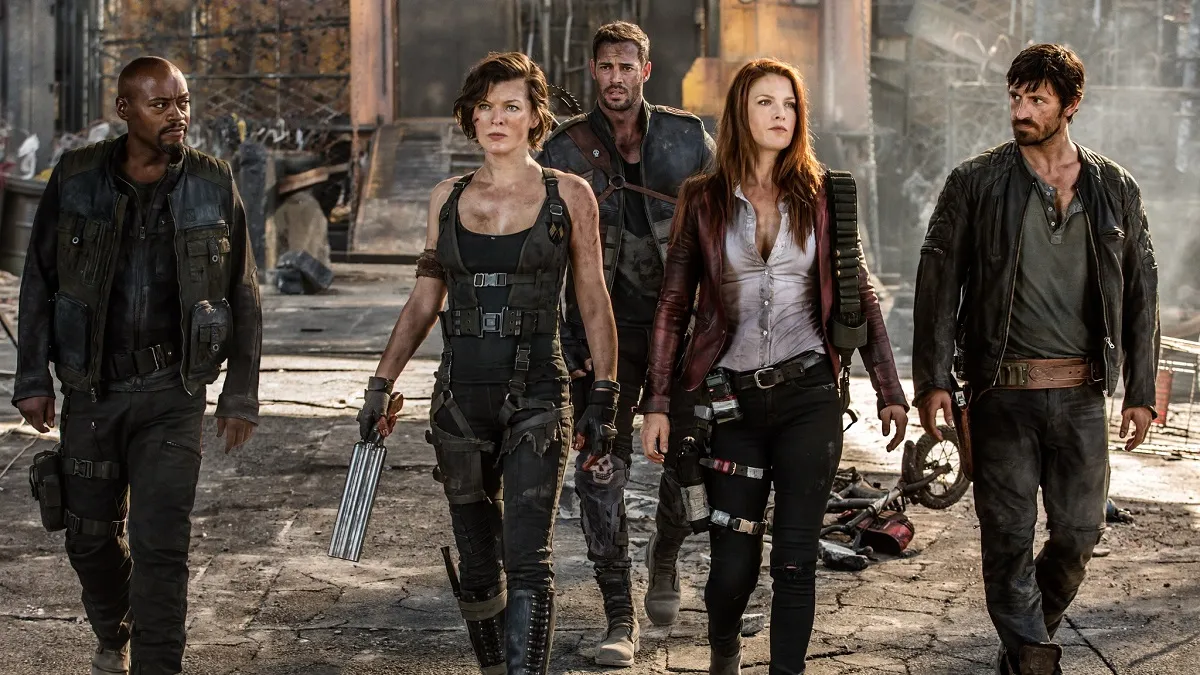Guys, that new Halloween movie was mediocre as f**k
Why hello, guys and ghouls, and welcome back to The 300, a feature on my spooky attempt to watch 300 movies in theaters in the year 2018. I’ll be watching new releases, classics, hidden gems, and festival films to experience the wide world of cinema in all its forms. With so much moviegoing variety, there ought to be something here for you to enjoy. If not, step into my laboratory and do the Monster Mash until you are content.
As always, there are three rules for The 300:
- The movie must be at least 40 minutes long, meeting the Academy of Motion Picture Arts and Sciences’ definition of a feature film.
- I must watch the movie at a movie theater, screening room, or outdoor screening venue.
- While I can watch movies I’ve seen before 2018, I cannot count repeated viewings of the same film in 2018 multiple times.
The senioritis of the last two weeks has let up slightly. I tried to watch mostly horror movies this week since it’s Halloween, but I broke my rule to catch a restoration of a Chantal Akerman movie. Maybe the loneliness that many artists feel is a kind of existential horror. Maybe. If anything, the Akerman films I’ve seen mirror my own bouts of alienation and solitude. Yet it can be so comforting to know that another person understands the melancholy shape of your isolation. While I still have so many of her movies left to see, 2018 is the year I became a Chantal Akerman fan.
I have 21 movies left to go. Drink up, bucko.
And so, onward.
275 of 300: The Ghost Story (1979)
(aka 鬼叫春; Gui jiao chun)

Director: Li Han-Hsiang
Starring: Hu Chin, Yueh Hua, Kung-Wu Huang
Country: Hong Kong
Seen at Metrograph (New York, NY)
Wednesday, October 24th
In the waning days of Shaw Brothers Studios, the venerable company did a whole lot of everything just to see what stuck. That included the tokusatsu/sci-fi superhero riff The Super Inframan (one of my favorite movies of all time) and a bunch of strange supernatural horror movies. The height of the supernatural madness is probably The Boxer’s Omen or Seeding of a Ghost both from 1983, though 1975’s Black Magic set the stage for the genre. The Ghost Story falls somewhere in the middle, and is also a kind of middling supernatural film and tawdry sex movie. The two-story anthology is all about spooky/sexy happenings in a period setting. The first tale is about a trio of women who turn men into bulls when they try to rape them or have sex with them. The second tale is about a powerful ghost that seduces a calligrapher with a fetish for foot binding.
It’s a sometimes kinky but mostly pervy horror film, though it lacks the gore and absurd imagination of the best supernatural Hong Kong movies. The second story has a remarkably bizarre magic battle at the end that hints at the glories of this subgenre, however. I’m also weirded out by the peculiar moralizing around each tale, as if these skeevy yarns really are meant for some sort of moral instruction.
Metrograph screened a strange print of the film. Roughly one-third of the movie was tinted magenta for some reason. For a while I assumed the magenta footage was meant to be cut out so the movie could air on television or be screened in a less-naughty form. A lot of the nudity and sex was tinted, so it made sense. Then again, the bonkers magic battle was also tinted, and that was the highlight of the film.
276 of 300: Halloween (2018)

Director: David Gordon Green
Starring: Jamie Lee Curtis, Judy Greer, Andi Matichak
Country: USA
Seen at AMC Empire 25 (New York, NY)
Thursday, October 25th
Everything that focuses on Laurie Strode and her family in this direct sequel to John Carpenter’s Halloween is great. It’s like Halloween but T2, and it deals with the generational fallout of trauma and violence. There’s such potential in the idea of a family with a large cloud hanging over them for decades, only for the storm to begin again 40 fateful years after it stopped.
Too bad that really good stuff only comprises about one-third of the runtime.
The rest of Halloween 2018 is a generic as f**k teen slasher movie. When Jamie Lee Curtis is off the screen, the film is completely devoid of personality. Michael Myers dutifully slays a bunch of people we don’t care about, and eventually, we reach the strong final act. Even the callbacks to the original Halloween and the now non-canonical Halloween sequels ring hollow. Ditto the sly homages to The Texas Chainsaw Massacre (that truck shot in the finale) and The Last House on the Left (dumb cops interrupting the main story). The Danny McBride comedy seemed misplaced, and so much of what happens felt like filler. Strode is where the drama is, and the same goes for her family. Why underdevelop their relationships and undercook the heart of the movie? What a missed opportunity. This could have been something special.
In my head, this is how Halloween 2018 breaks down:
- 30% Fascinating exploration of generational violence/trauma
- 28% Generic horny teen slasher movie
- 15% Clunky fan service
- 10% People doing dumb things because horror movies
- 8% The worst season of the podcast Serial
- 7% Hanging out with boring, slow-ass cops
- 2% Jokes about Vietnamese sandwiches
277 of 300: Maniac (1980)

Director: William Lustig
Starring: Joe Spinell, Caroline Munro, Tom Savini
Country: USA
Seen at Roxy Cinema Tribeca (New York, NY)
Friday, October 26th
Maniac may be one of the sleaziest slasher movies ever made. It’s a dirty scumbag of a film, but that’s the point. William Lustig made a move that’s effectively difficult to watch, and even seasoned gorehounds (which I used to be in my teens and early twenties) will probably want to take a shower after seeing this. Lustig’s Maniac takes place on the grimy streets of New York City, with a fully committed Joe Spinell playing a deranged, misogynistic serial killer. The film’s POV shots are unsettling, the sound dominated by Spinell’s breath, his murmuring, and his moans, which communicate both longing and rage. These shots likely inspired the POV conceit of the 2012 Maniac remake starring Elijah Wood. Sure, there are schlocky and unbelievable moments in Maniac (e.g., why would Caroline Munro’s character even consider talking to this sweaty, creepy schlub?), but the film functions as a gorehound artifact, a vessel for corn syrup, rubber latex, and revulsion.
Tom Savini’s makeup effects are reaching their peak at this point. There’s something about the gore effects he did during the 1980s that scream “classic.” In Maniac, we have one of the most infamous head shots ever captured on film. Savini’s own head gets blowed up real good. There’s also a gruesome finale that seems like a precursor to an effect Savini later perfected in George Romero’s Day of the Dead.
Outside of The 300: The Maniac Pre-Show Q&A

There was another projection mishap this week. The Roxy Cinema Tribeca intended to screen the 4K restoration of Maniac that evening, with William Lustig himself in attendance for a Q&A. Unfortunately, the DCP wasn’t fully downloaded. Worse, once the DCP was downloaded, the keys for the film didn’t work and they had to get new ones. This led to some stalling on the part of William Lustig and the Roxy Cinema team, and ultimately the program running 45-50 minutes behind schedule. It might have been more, but my phone was dead and I couldn’t check the time. I felt bad for Lustig and the Roxy staff, but they made the most out of bad situation.
The post-film Q&A became a pre-film conversation with Lustig, whose long career in film includes working on pornos in NYC during the 1970s, turning Anchor Bay into the cult movie version of the Criterion Collection during the 1990s, and founding Blue Underground. While handing out free popcorn in the lobby, Lustig called up his friend Nicolas Winding Refn. Yes, the director of Bronson, Drive, The Neon Demon, and more was called up spontaneously and chatted with Lustig in front of the patient audience. During the call, Refn was at work on the color grading for the series Too Old to Die Young, which comes out on Amazon next year. He talked about being a fan of Lustig’s for years, and called Maniac an arthouse movie given its immersion in the protagonist’s psyche. At some point, Refn will remake Lustig’s Maniac Cop, and he intends to work with Ryan Gosling again in the future.
In one of the goofier moments in this surreal pre-show, Refn said he meditates through doing LEGOs. He has almost completed making the Millennium Falcon, which has 7,500 pieces.
Don’t ever change, Nic.
278 of 300: Les Rendez-vous d’Anna (1978)
(aka The Meetings of Anna)

Director: Chantal Akerman
Starring: Aurore Clément, Jean-Pierre Cassel, Magali Noël, Helmut Griem
Country: France/Belgium/West Germany
Seen at BAM Rose Cinemas (Brooklyn, NY)
Monday, October 29th
Like Chantal Akerman’s masterpiece Jeanne Dielman, 23 Quai du Commerce, 1080 Bruxelles (The 300 Week 31), Les Rendez-vous d’Anna is a movie about loneliness. We watch as fictional filmmaker Anna Silver (Aurore Clément) travels to Germany promote her latest film, and then back to Paris to find out where she’s headed next. In the opening shot, we see a train platform fill with people descending stairs, but Anna steps away from the crowd, alone. That solitude is the essence of this film. She sits in empty hotel rooms, she stares out windows at passing trains, and she looks so ruminative and forlorn while in transit. Her relationships are similarly transitory, and there’s a sense that she’s not particularly tethered to any place or connected to anyone. It’s the sadness of the artist’s freedom, and the realities of the grind. We watch Anna struggle through a crowded train car. She wants to be alone, but she really wants to be with others. The most peaceful she seems is when staring out at the night with another lonesome traveler.
Les Rendez-vous d’Anna should be boring, and it may be to some people, but if you’ve ever felt an extreme loneliness, these images of alienation and isolation ring true. So many shots have such a haunting, melancholy quality about them. During Anna’s silences, I wondered what she was thinking, and wondered if I have had the same thoughts in similar moments of my life. Clément’s face registers subtle shifts in emotion, so each lightening of the eyes or twitch of a smile invites both mystery and empathy. Similarly, when Anna’s eyes grow watery, it’s heartbreaking. The movie is like an Edward Hopper painting, but somehow sadder, lonelier, and also more French.
Cinematographer Jean Penzer mostly keeps his camera still, with each tableau highlighting the distance, separation, and isolation of characters, with the occasional sense of tender togetherness. There are several lovely, energetic tracking shots in the movie. I sensed they were meant to evoke the sensation of train travel, or of a life on rails that may never feel completely within Anna’s control. Come to think of it, even when she is inside of cars, we never once see her behind the wheel. This is a new Janus Films restoration of the movie, which means there will likely be a new Criterion Collection release of this absorbing and heartachingly beautiful character study.
279 of 300: Pitfall (1962)
(aka おとし穴; Otoshiana)

Director: Hiroshi Teshigahara
Starring: Hisashi Igawa, Sumie Sasaki, Sen Yano, Kunie Tanaka
Country: Japan
Seen at BAM Rose Cinemas (Brooklyn, NY)
Tuesday, October 30th
Pitfall is the feature film directorial debut of Hiroshi Teshigahara, and his first collaboration with writer Kobo Abe and composer Toru Takemitsu. This trio would go on to make The Woman in the Dunes (The 300 Week 25), The Face of Another, and The Man Without a Map. While not as polished or refined as their later collaborations, Pitfall is a startling anti-capitalist ghost story that gets at the horror of coal miner exploitation in post-war Japan. An unemployed miner (Hisashi Igawa) is murdered in a dilapidated ghost town as a means of pitting two labor unions against one another. He returns as a spirit, unable to communicate the facts of his own death. Around him, other ghosts appear. They toil as they once did, silent, oblivious to the ugliness of the world that passes by around them.
While some of the middle drags, Teshigahara’s imagery takes on an incredible power by the end. Pitfall is not necessarily scary so much as it is chilling, and a reminder of the worst impulses of corporations and mankind. The film might pair well in an unexpected double feature with Henri-Georges Clouzot’s The Wages of Fear (The 300 Week 2), Robert Greene’s Bisbee ‘17 (The 300 Week 34), or Barbara Kopple’s Harlan County, USA.




